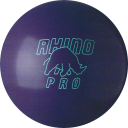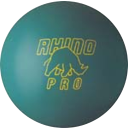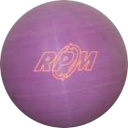
Both the Purple Rhino Pro (PRP) and Black Rhino Pro (BRP) are conventional two piece balls. Each contains a shaped core as one piece and a urethane cover stock as the second piece. The core shape is the same in both the PRP and BRP while the cover stocks of the two balls are different.
The core shape can be described as a sphere with a cylinder extending from the top and a shorter cylinder extending from the bottom. The green riser pin that can be seen on the surface of the ball in the label area shows the center line along the long axis of the core. As can be seen from the top view diagram, the core is symmetric around the pin, making the Rhino Pro a conventional two piece design.
The shell of the PRP, which is quickly becoming known as a highly responsive material, is made from a new type of urethane formulation that is significantly different from those used in other Brunswick Urethane balls to date.
The unique characteristic of the PRP cover stock is that it responds more strongly to the lane surface than a conventional urethane does. Thus the PRP reacts more strongly on dry lane surfaces, but reacts less strongly on medium and heavily oiled lane surfaces than traditional urethane cover stocks. On most lane conditions, the Purple Rhino Pro has the potential to react less in the heads but react more on the back ends than other urethane bowling balls.
Bowlers have come to expect the surface of the PRP to have a "tacky" feel. The degree to which the surface feels tacky is dependent on how much the ball has been polished. The greater the polish, the tackier the feel. Polishing your PRP in a Lustre King or Lustre Kleen increases the tacky feeling of the cover stock.
Because of the unique characteristics of this type of urethane, sanding and polishing the ball can cause different changes in the ball's reaction than might be expected.
Polishing the PRP will tend to make the ball react less in the heads and react stronger on the back ends if they are dry. If the PRP is reacting too strongly on a lane that has dry back ends, polishing can cause an even stronger back end reaction and thus may not provide the desired change in reaction.
Sanding the PRP will cause the ball to react more in the heads but will limit the change in direction in the back ends. This will give the ball a more even reaction that is closer to that of a conventional urethane cover stock. If a PRP is reacting too strongly on a lane that has dry back ends, sanding the surface will cause the ball to roll sooner. This can even out the trajectory and make the ball more usable on this condition. If a PRP is reacting too weakly on an oily lane, sanding the surface will cause the ball to roll sooner, giving a reaction that is closer to conventional urethanes. On heavily oiled lanes no amount of sanding will make a PRP go long and hook hard like a shiny PRP on a lane with dry back ends.
Comparing reactions between the PRP and BRP, both sanded and shined, is difficult because the total reaction the bowler will see depends on the combination of the ball, the lane condition and the bowler's technique. For medium to heavily oiled lanes, conventional urethanes such as the Black Rhino Pro may provide a more usable reaction. On very oily lanes with lots of carry down the BRP may tend to react more than a PRP. On more medium amounts of oil, crowned or blocked conditions. the PRP may tend to react more than the BRP.
HR - Highly Responsive Coverstock
Rhino Pro 2-Piece Core

16 pounds
15 pounds
14 pounds
Shop
Similar Balls
| Ball | Brand | Comparison Grade | Coverstock | Factory Finish | Core | RG | Diff | MB Diff | US/Overseas Release | Discontinued | |
|---|---|---|---|---|---|---|---|---|---|---|---|

|
Purple Rhino Pro | 
|
HR - Highly ResponsiveSolid Reactive | Polished | Rhino Pro 2-PieceSymmetric | 2.550 | 0.015 | ||||

|
Ninja | 
|
A | Ninja ReactathaneSolid Reactive | Polished | NinjaSymmetric | 2.550 | 0.020 | |||

|
Crush/R | 
|
A- | Crush/RSolid Reactive | Sanded | Crush/RSymmetric | 2.550 | 0.015 | |||

|
Shock Wave | 
|
A- | Shock WaveSolid Reactive | Polished | Shock WaveSymmetric | 2.550 | 0.020 | |||

|
LT-48 Gold | 
|
A- | LT-48 GoldSolid Reactive | Polished | LT-48 GoldSymmetric | 2.550 | 0.020 | |||

|
Ninja Fury | 
|
A- | Ninja Fury ReactathaneSolid Reactive | 240 Grit Sanded | NinjaSymmetric | 2.550 | 0.020 | |||

|
Ninja Master | 
|
A- | Ninja Master ReactathaneSolid Reactive | 600 Wet Sand | NinjaSymmetric | 2.550 | 0.020 | |||

|
Cyber-XR | B+ | Cyber-XRSolid Reactive | Sanded | Cyber-XRSymmetric | 2.550 | 0.020 | ||||

|
Red Wolf | 
|
B+ | Mega BiteSolid Reactive | 600 Wet Sand | Wolf (1990s)Symmetric | 2.550 | 0.020 | |||

|
Rhino Pro Teal | 
|
B+ | Reactive UrethaneSolid Reactive | 320 Wet Sand | Teal Rhino Pro LightbulbSymmetric | 2.542 | 0.024 | |||

|
Thrill (various colors) | 
|
B | Agility XP (Striking Precision)Solid Reactive | 5500 LSP | FluxSymmetric | 2.570 | 0.015 | |||

|
Pulse (1996) | 
|
B | Super-Flex ResinSolid Reactive | 600 Satin | Pulse 2-pieceSymmetric | 2.581 | 0.018 | |||

|
Ninja RPM | 
|
B | Ninja ReactathaneSolid Reactive | 600 Matte | RPM NinjaSymmetric | 2.520 | 0.025 | |||

|
The Vamp | 
|
B- | MBS-17Solid Reactive | 1500 Polished | FangSymmetric | 2.580 | 0.016 | |||

|
Avalanche Solid | 
|
B- | PowrKoil 18 SolidSolid Reactive | Rough Buff | Teal Rhino Pro LightbulbSymmetric | 2.542 | 0.024 | |||

|
Rack Attack Solid | 
|
B- | Rack Attack SolidSolid Reactive | 500/4000 Siaair Micro Pad | Rack AttackSymmetric | 2.542 | 0.024 | |||

|
Clash Turquoise/Purple | 
|
B- | Modified Phazed Bomber ReactiveSolid Reactive | Polished | Modified AsymmetricAsymmetric | 2.530 | 0.025 | 0.010 | ||

|
Tropical Breeze Solid Black / Teal | 
|
B- | Reactor SolidSolid Reactive | 1500 Polished | CamberSymmetric | 2.570 | 0.009 | |||

|
Shout (2014) | 
|
B- | 45L SolidSolid Reactive | 1500 Polished | Late Roll 46Symmetric | 2.570 | 0.022 | |||

|
Shout (2013) | 
|
B- | 45L SolidSolid Reactive | 3000 Abralon | Late Roll 46Symmetric | 2.570 | 0.022 | |||

|
Shout (2012) | 
|
B- | 45L SolidSolid Reactive | 1500 Polished | Late Roll 46Symmetric | 2.570 | 0.022 | |||

|
Alley Cat (various colors) | 
|
B- | ACRSolid Reactive | 500 Siaair, Crown Factory Compound, Crown Factory Shine | Alley CatAsymmetric | 2.564 | 0.025 | 0.001 | ||

|
X-Calibur Raspberry | 
|
B- | X-Calibur RaspberrySolid Reactive | Matte | X-CaliburSymmetric | 2.550 | 0.040 | |||

|
Match | 
|
B- | Reactor SolidSolid Reactive | 2000 Abralon | StingerSymmetric | 2.550 | 0.030 | |||

|
Rumble | 
|
B- | 55MSolid Reactive | 2000 Abralon | Late Roll 51Symmetric | 2.550 | 0.030 |